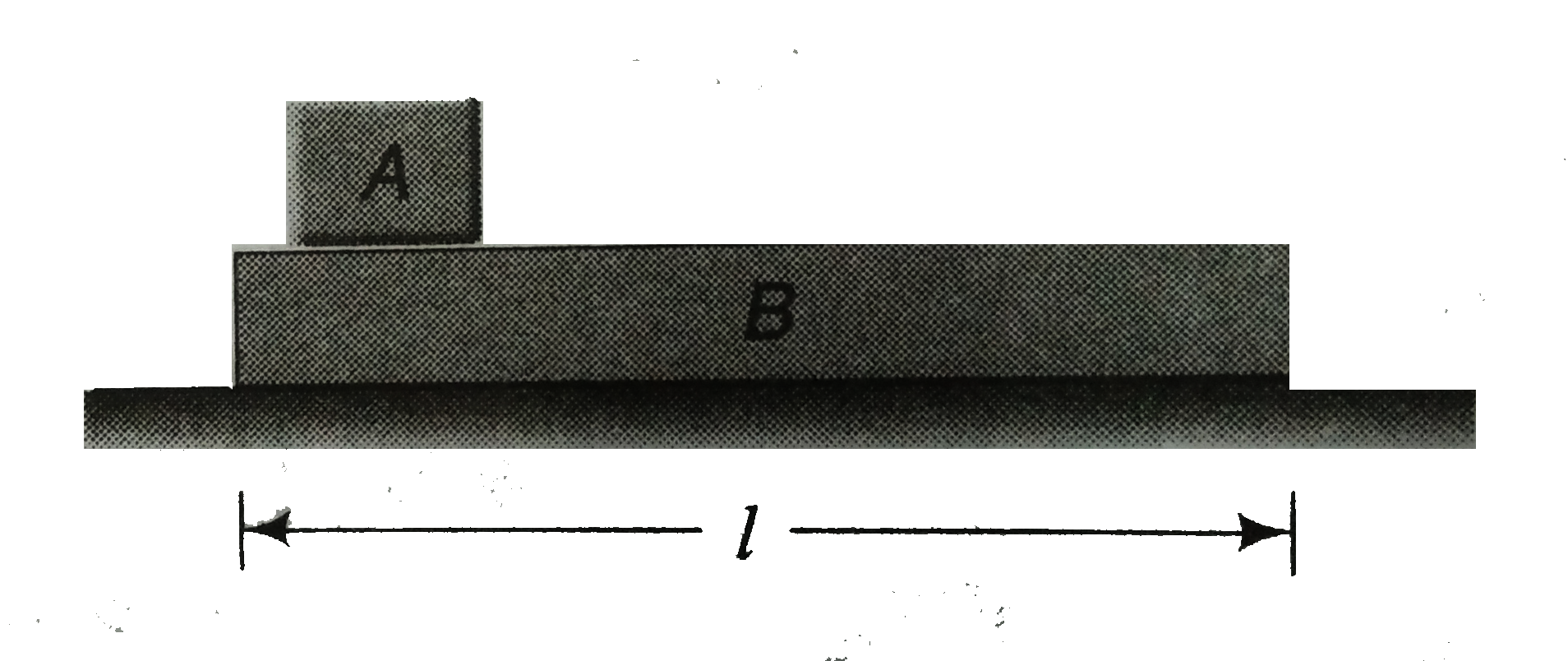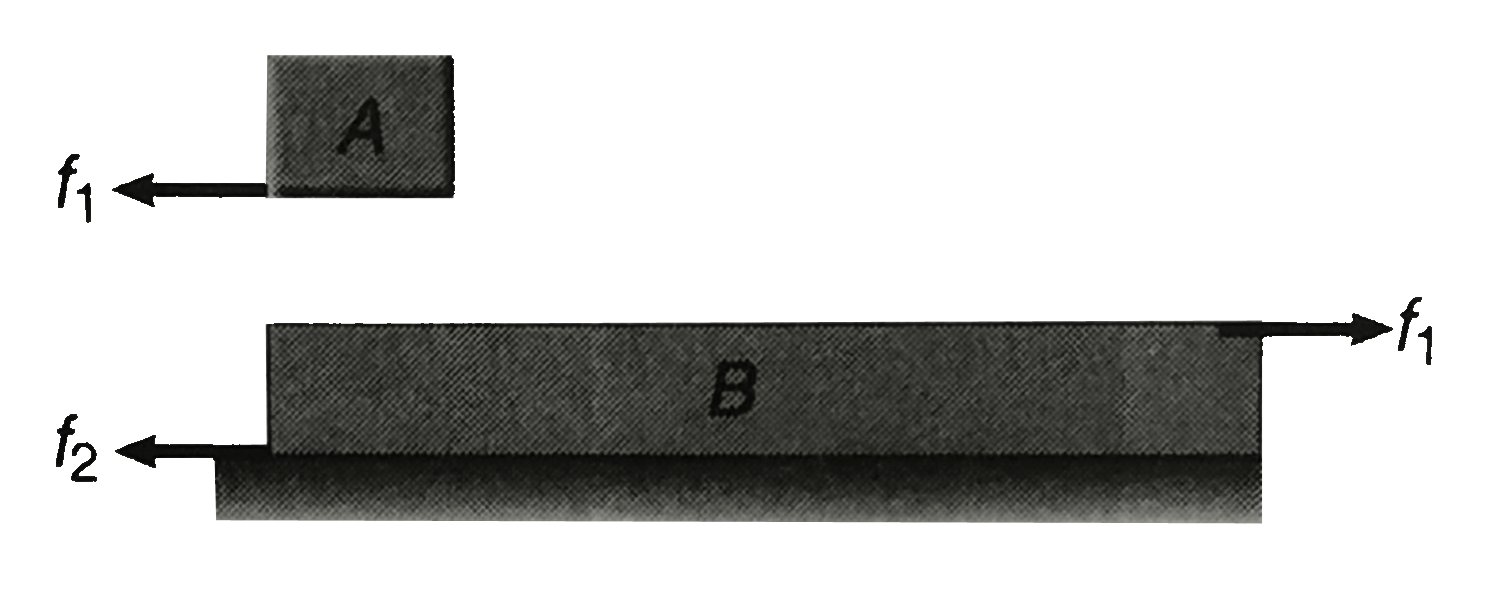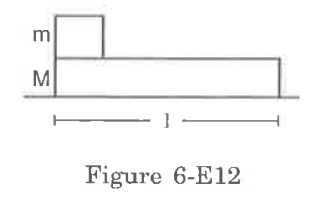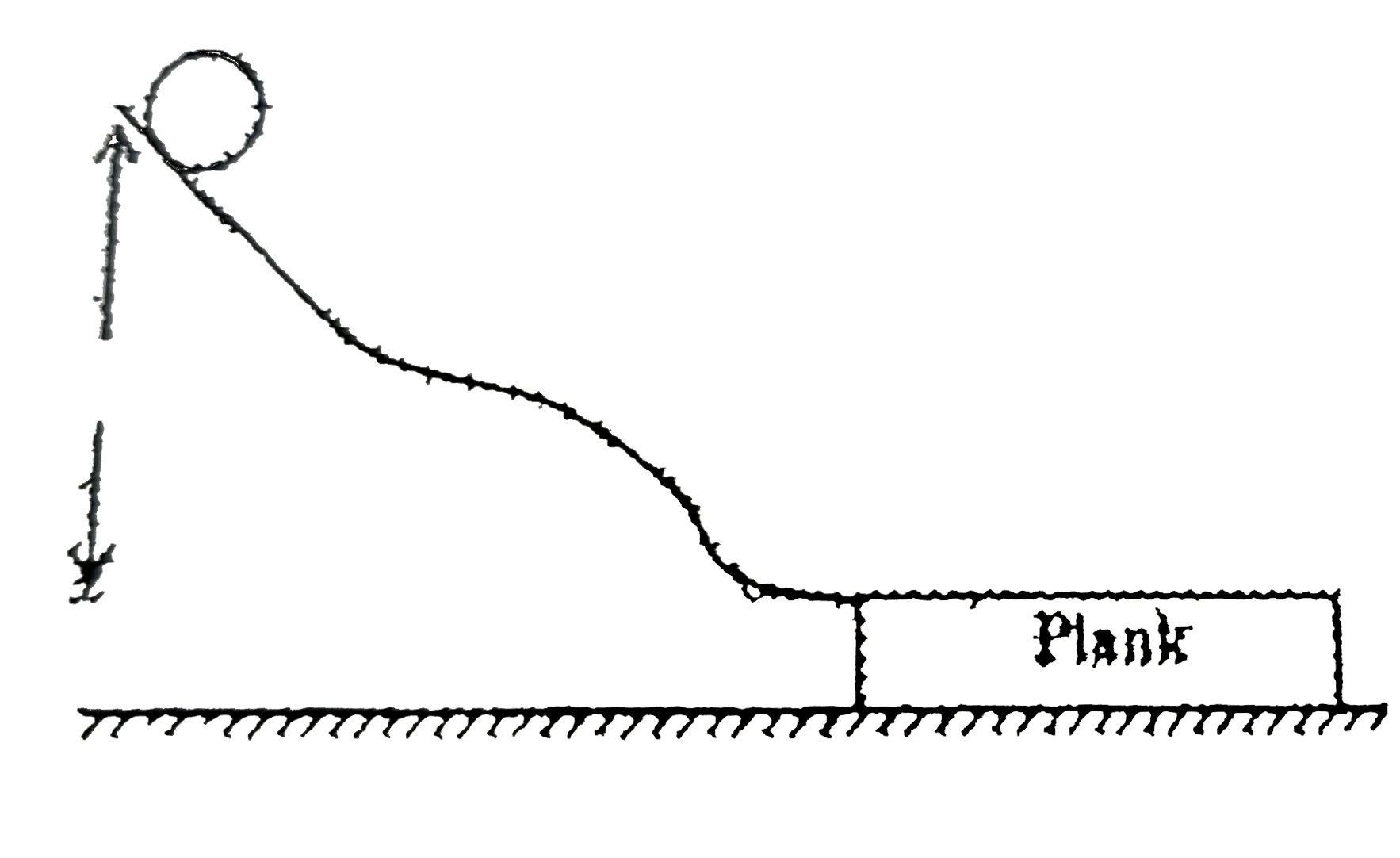Figure shown a small block A of mass m kept at the left end of a plank B of mass M=2m and length l . The system can side on a horizontal rood. The system is started towards right with the initial velocity v. The friction coefficient between the rood and the plank is 1/2 and that between the plank and the block is 1/4 . Find

(a) the time elapsed before the block separates from the plank
(b) displacement of block and plank relative to ground till that moment.
There will be relative motion between block and plank and road. So at each surface limiting friction will act. The direction of friction forces at different surfaces are as shown in figure.

Hence f1=(14)(mg)
and f2=(12)(m+2m)g=(32)mg
Retardation of A is a1=f1m=g4
and retardation of B is a2=f2−f12m=58g
Since a2>a1
Relative acceleration of A with respect to B is
ar=a2−a1=38g
Intial velocity of both A and B is v. So there is no relative intial velocity. Hence,
(a) Applying s=12at2
or ι=12art2=316gt2
:. t=4√l3g
(b)Displacement of block sA=uAt−12aAt2
or sA=4u√l3g−12.g4.(16l3g) (aA=a1=g4)
or sA=4u√l3g−23l
Displacement of plank sB=uBt−12aBt2
or sB=4u√l3g−12(58g)(16l3g) (aB=a2=58g)
or sB=4u√l3g−53l
Topper's Solved these Questions
- BOOK - DC PANDEYCHAPTER - LAWS OF MOTIONEXERCISE - Exercise 8.110videos
LAWS OF MOTION
- BOOK - DC PANDEYCHAPTER - LAWS OF MOTIONEXERCISE - Exercise 8.29videos
LAWS OF MOTION
- BOOK - DC PANDEYCHAPTER - LAWS OF MOTIONEXERCISE - Medical entrances gallery39videos
LAWS OF MOTION
- BOOK - DC PANDEYCHAPTER - KINEMATICS 1EXERCISE - INTEGER_TYPE15videos
KINEMATICS 1
- BOOK - DC PANDEYCHAPTER - LAWS OF THERMODYNAMICSEXERCISE - Level 2 Subjective18videos
LAWS OF THERMODYNAMICS
Similar Questions
Figure shows a small block of mass m kept at the left end of a larger block of mass M and length l. The system canslide on a horizontal road. The system is started towards right with an initia velocity v. The friction coefficient between the road and the bigger block is μ and that between the block is μ2. Find the time elapsed before the smaller blocks separates from the bigger block.
 View Solution
View SolutionA small block of mass 'm' is placed on a plank of mass 'M'. The block is connected to plank with the help of a light string passing over a light smooth pulley as shown in figure. The co-efficient of static friction between the block and plank is μ.

The co-efficient of friction between the plank and the horizontal surface is zero. What maximum horizontal force F applied on the block of mass m can make the block and plank not to slide relatively?View Solution
Knowledge Check
- Question 1 - Select One
A plank of mass 2kg and length 1m is placed on horizontal floor.A small block of mass 1kg is placed on top of the plank , at its right extreme end .The coefficient of friction between plank and floor is 0.5 and that between plank and block is 0.2 . If a horizontal force =30N starts acting on the plank to the right ,the time after which the block will fall off the plank is (g=10ms−2)
A(23)sB1.5sC0.75sD(43)s - Question 2 - Select One
A block of mass m is gently placed over a massive plank moving horizontal over a smooth surface with velocity 10ms−1. The coefficient of friction between the block and the plank is 0.2. The distance travelled by the block till it slides on the plank is [g=10ms−2]
A10 mB15mC25 mD35m - Question 3 - Select One
A block of mass m is placed gently onto a long plank of mass M moving with a velocity v0 on a smooth horizontal floor. If friction is present between M and m :
 Avcentre of mass=Mv0M+mBWfriction on m is positiveCWFriction on M is negativeDfinal velocity of both =mv0m+M
Avcentre of mass=Mv0M+mBWfriction on m is positiveCWFriction on M is negativeDfinal velocity of both =mv0m+M
In the figure shown, a solid sphere of mass 'm' and radius r is released from a height 6r to slide down a smooth surface. A plank of same mass 'm' touches the horizontal portion of the surface at the ground. The co-efficient of friction between the plank and the sphere is μ and that between the plank and the ground is μ/4. Find the work done by the friction force between the plank and the ground till the sphere starts pure rolling on the plank. Neglect the height of the plank.
 View Solution
View SolutionA block is kept on a rough horizontal plank. The coefficient of friction between the block and the plank is 12. The plank is undergoing SHM of angular frequency 10 rad/s. The maximum amplitude of plank in which the block does not slip over the plank is (g= 10 m/s2)
View SolutionA block is placed over a plank. The coefficient of friction between the block and the plank is μ=0.2. Initially both are at rest, suddenly the plank starts moving with acceleration a0=4m/s2. The displacement of the block in 1 is (g=10m/s2)
View SolutionA block is over a plank . The coefficient of friction between the block and the plank id μ=0.2Initially both are at rest , suddenly the plank starts moving with accleration α0=4m/s2 The displacement of the block in s is (g=10m/s2)
View SolutionA block of mass m =2 kg is placed on a plank of mass M = 10 kg, which is placed on a smooth horizontal plane as shown in the figure. The coefficient of friction between the block and the plank is μ=13. If a horizontal force F is applied on the plank, then the maximum value of F for which the block and the plank move together is (g=10m/s2)
 View Solution
View Solution

